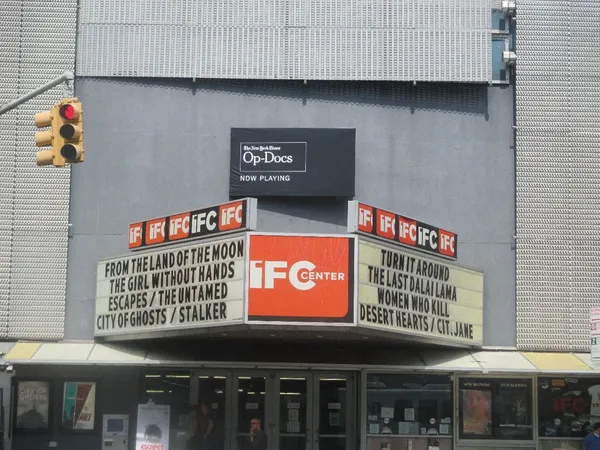 |
| Escapes at the IFC Center: "It's like that Thom Andersen movie Los Angeles Plays Itself. This is not a portrait of a place but a portrait of a person." Photo: Ed Bahlman |
Escape artist Hampton Fancher reveals beating out Jean-Pierre Léaud and the pathway that led him to star in Michael Pfleghar's Romeo und Julia 70, opposite Tina Sinatra. Norman Taurog's Blue Hawaii starring Elvis Presley and Joan Blackman, Teri Garr, Brian Kelly and Flipper surface. Michael Almereyda makes a Skinningrove (his film on photographer Chris Killip) connection to a scene with Harrison Ford in Ridley Scott's Blade Runner and remarks "it's called Escapes for a reason as almost every episode involves a near-death experience."
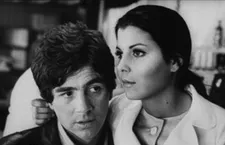 |
| Hampton Fancher starred with Tina Sinatra in Michael Pfleghar's Romeo Und Julia 70 |
When do you think you know a person? What does this knowing entail? A face, a name, a voice, dates and other facts? Or is it the stories they tell? Michael Almereyda's Escapes is less a portrait of Hampton Fancher (co-screenwriter of Blade Runner and Blade Runner 2049) than it is a collage of an essence of his multi-faceted lives. The film is structured around seven shiny shards of adventure and a coda (if Hampton were a cat, there'd be at least two more to look forward to in an Escapes P.S.).
Anne-Katrin Titze: In Escapes, television looms large which can have, I think, an unintended effect. You, Hampton, are telling stories of your life, at the same time, the images, chosen by you, Michael, possibly confront audiences with their own memories of these television shows.
Michael Almereyda: You're presuming the age of the audience members. A lot of this stuff is just beyond the reach of my memory. So I wasn't consciously thinking of that. I was using it as a sort of alternate universe that could embody and subvert and focus some of the adventures Hampton had, because he is literally playing himself.
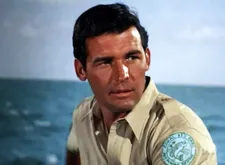 |
| Chapter 4, titled The Stranger Who Looks Like Me, is about Hampton's friendship with Brian Kelly |
It's like that Thom Andersen movie Los Angeles Plays Itself. This is not a portrait of a place but a portrait of a person. The multi-faceted nature of that person. So for me it was a conceit. I wasn't trying to elicit nostalgia for those shows. Did you remember seeing any of those images and shows?
AKT: Flipper. I loved watching it on television when I was very little [in what must have been endless reruns as the entire series aired before I was born]. What was fascinating for me seeing Escapes was that I had forgotten your friend [to Hampton], Brian Kelly, and that there even was a father. I just loved that world and wanted to live in it.
MA: That says a lot about you. So it's that particular show?
AKT: That particular one, yes. But I could imagine this happening to other people, too, no matter the age. People can have nostalgia for things they never saw. There must have been reruns of Bonanza on American television?
MA: Sure. This film took a long time to make and my two editors [Piibe Kolka, Daryl Meador] are both in their twenties, so we weren't thinking about nostalgia or cultural echoes. We were using it as raw material.
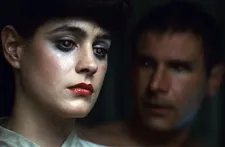 |
| Sean Young with Harrison Ford in Blade Runner, co-written by Hampton Fancher |
Hampton Fancher: When did it come to you that you were going to structure it as it wound up being structured? Because we were shooting a lot of different stories that weren't used.
MA: The instigation was I made a short film called Skinningrove about a photographer [Chris Killip] who talks about his images and you are given access to information you couldn't possibly know from looking at the images. It's like a world, a trapdoor opens up within the pictures.
In an eerie way, it's like that part of Blade Runner where Harrison Ford enters a photograph and is able to go into a space that isn't actually in the frame. And that's fairly moving to me to imagine how much pictures do and don't reveal. And I wanted to make a short film based on a story Hampton told me about the filming of Blue Hawaii, the Elvis Presley movie, where his girlfriend [Joan Blackman] at the time was starring with Elvis.
And it's a wonderful story and I wanted to illustrate it the way we ended up using images in Escapes. But after Hampton told it, he also told the story about Teri Garr. And as I talked to him more, I realised that there were a series of stories that had a shape and a structure more meaningful than just being randomly entertaining. So there is a real purpose in the way the film is arranged.
 |
| Hampton Fancher with Ray Charles and Michael Pfleghar |
And it's called Escapes for a reason, as almost every episode involves a near-death experience. An experience that you emerged transformed in some way. It can seem offhand and just kind of splashed together but it was actually done with care.
AKT: You see the care.
HF: Yeah, it's like Bach, just like a little fugue to me.
AKT: At the same time - sorry to go from Bach to this - it also unfolds a bit like a narrative striptease. At first there's only your voice, then you tease us with a foot and then we see images from childhood. So maybe a striptease or magician's act?
MA: Well, I take the magician's act.
HF: I like the striptease. My sister worked as a stripper.
MA: We know that. Okay, we'll take both.
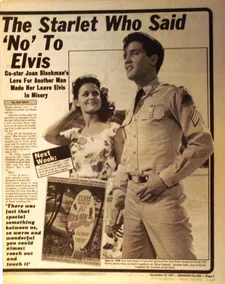 |
| Blue Hawaii stars Joan Blackman (Hampton's girlfriend at the time) and Elvis Presley |
HF: Do we say that in the film?
MA: Yeah, that you helped her with her dance routines. There's a picture of you leaning closely against her breasts.
AKT: There are so many unexpected twists and turns in the narrative.
MA: It's a film about fate. Luck and fate. A fair bit of luck.
HF: Oh, yeah, a lot of luck.
AKT: What do you think about fate?
HF: I don't think about pre-determined fate but fate's a handy word. I think about luck. It's just timing, you know. You walk around the corner and get killed or you walk around the corner and meet your love. It's coincidental.
MA: But I think you have a way of activating luck too.
HF: There are certain advantages one can own. And I've had a certain advantage in my life. But there's luck and, yeah, I did take advantage of it. Like, if I hadn't gone into dancing, I would have had a completely different life and it probably would have been a very bad one. It probably would have ended very badly, I think.
MA: Your life as a juvenile delinquent?
HF: Yeah. So without the dancing…
AKT: Are there excerpts from the Tina Sinatra film in Escapes? That is not the Cheerleader film?
MA: When he is talking about the Cheerleader film, you see it. But there's an indiscriminate use of many films throughout the movie. It's a mosaic and that film with Tina Sinatra is extensively excerpted. Because it's really Hampton's one big leading role. It's an epic. A re-imagining of Romeo And Juliet.
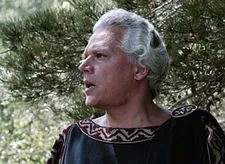 |
| Andreas von Rauch in Danièle Huillet and Jean-Marie Straub's The Death Of Empedocles wanders through Escapes |
AKT: It is?
HF: It was called a couple of things. It was called Romeo Und Julia 70 and it was also called The Year Of The Jokers. I think it was for Eurovision, if you remember that? Because it was three hours long.
AKT: And Michael Pfleghar directed it?
HF: Yes. It was an interesting premise because the world is in tumult at that point. '68 a lot of stuff was going on, assassinations, etc., and the world was in revolt. So his idea was - he came to William Morris [Agency] in Beverly Hills. What was his name, Jean-Paul Léaud? Truffaut's guy?
AKT: Jean-Pierre Léaud.
HF: Yeah, Jean-Pierre Léaud. He was supposed to do it. And then Michael Pfleghar came to sign Tina Sinatra in L.A.. And somebody at William Morris said "You got to see this guy." [Hampton points at his chest] So he did.
AKT: And he forgot all about Jean-Pierre Léaud!
HF: And he forgot about that. My English is better than his. Not my German and French. The premise was interesting. How would Romeo and Juliet succeed in falling in love in a world with so much against them? You know, with all the distractions - political, financial, ambition, all that. Romeo And Juliet couldn't happen in 1968 was the idea.
_225.webp) |
| Hampton Fancher on Romeo Und Julia 70: "I would talk to Nixon or I would talk to Frank Sinatra or ask questions." |
So it was taking this young guy and this young girl who both were innocent and then the narrative was him achieving certain goals and how they became corrupted. It wasn't a strict script, it was improvised a lot. It was like, I would talk to Nixon or I would talk to Frank Sinatra or ask questions. It was then about the fall of our relationship to our death. It opens up with a scene in our coffins in a graveyard and then it goes back. It was ridiculous and yet it had a conceit that was really interesting.
AKT: Was it episodic?
HF: No it was just three hours straight.
MA: It was episodic in a way because it was broken up with interviews.
HF: Yeah, it was definitely episodic in that way. I thought you meant in its release.
AKT: No, I meant the structure. A bit like your film, Michael, built from seven chapters, seven escapes [and a coda].
HF: [Pfleghar's film] was made in the cutting room. We went around the world two times. You know, he had endless money, small crew. I wrote a lot of it. It was adventurous. I shot some of it. It was fun.
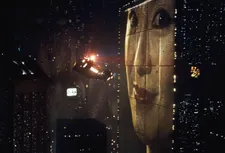 |
| Ridley Scott's Blade Runner from 1982 |
AKT: And it disappeared?
MA: We found a copy.
HF: It didn't get released in America. It was almost released theatrically but then something happened. It was popular in Europe on television. At that time it was the biggest seen event on television. They did it two nights running.
Read what Hampton Fancher and Michael Almereyda had to say on Philip K Dick, Blade Runner 2049 and the original Blade Runner.
Read what Michael Almereyda and Hampton Fancher had to say on time, Federico García Lorca, telling stories in Escapes, Chris Marker, Yasujiro Ozu and Bruce Conner.





















